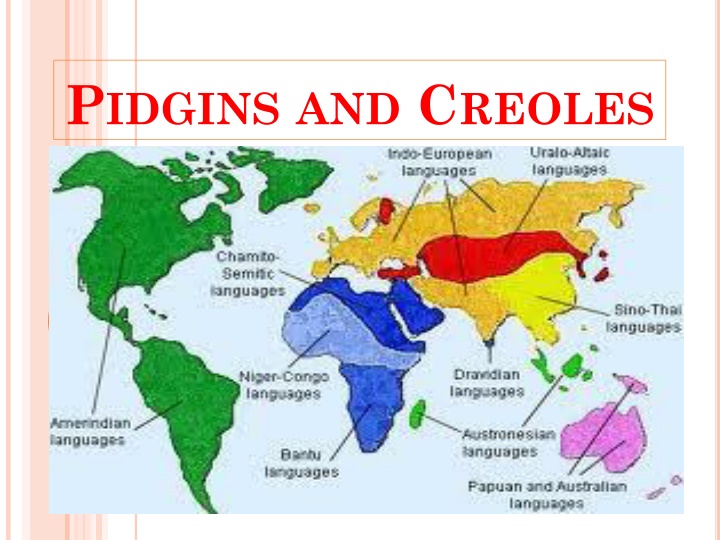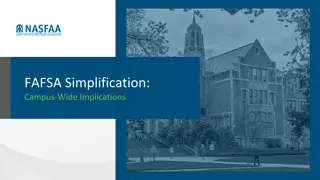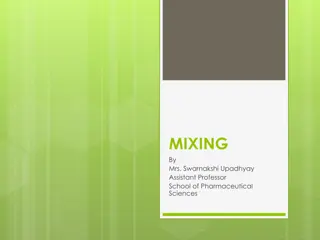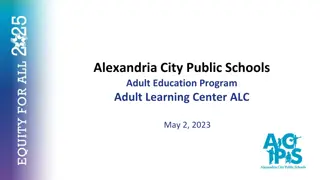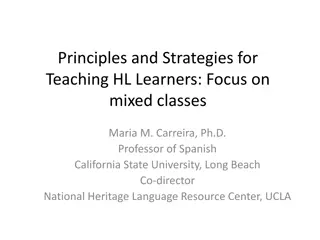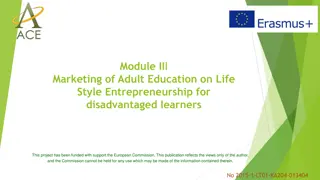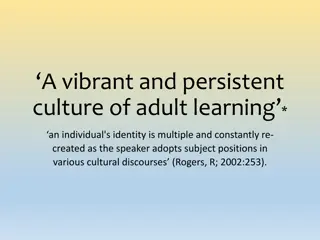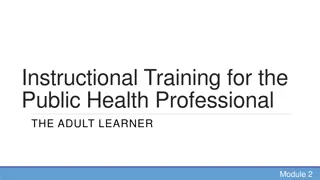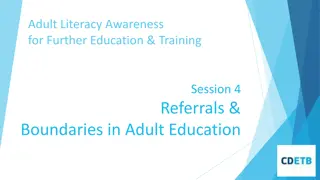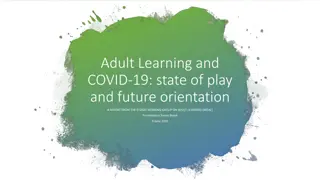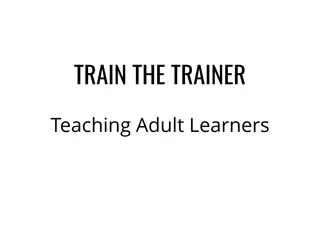Language Simplification, Mixing, and Reduction in Adult Learners
Adolescents and adults face challenges in learning foreign languages, often leading to simplification, mixing, and reduction in their speech. These processes involve regularization, loss of redundancy, and the introduction of elements from their native language. This pidginization occurs when language learning occurs over an extended period.
Download Presentation

Please find below an Image/Link to download the presentation.
The content on the website is provided AS IS for your information and personal use only. It may not be sold, licensed, or shared on other websites without obtaining consent from the author.If you encounter any issues during the download, it is possible that the publisher has removed the file from their server.
You are allowed to download the files provided on this website for personal or commercial use, subject to the condition that they are used lawfully. All files are the property of their respective owners.
The content on the website is provided AS IS for your information and personal use only. It may not be sold, licensed, or shared on other websites without obtaining consent from the author.
E N D
Presentation Transcript
PIDGINS & CREOLES INTRODUCTION
Adolescents and adults tend to be rather bad language learners and only in very rare instances manage to learn foreign languages so well that they can speak them exactly like native speakers.
Whenever someone attempts to learn another language, certain processes which stem from this imperfect learning ability will almost always occur. In particular, in the speech of such adult language learners, the language in question will be, to different degrees, simplified and mixed.
Simplification is understood as involving regularization and loss of redundancy. Regularization means treating irregular forms as if they were regular, such as when a learner of English said I buyed rather than I bought. Loss of redundancy often involves the omission of grammatical material which is repeated elsewhere or is not absolutely necessary for conveying the message intended, as when a learner of English says she like rather than she likes.
Mixing is a term which refers to the way in which language learners introduce elements from their own language into the language they are attempting to learn. For example, a French-speaking learner of English will almost certainly have a French accent in their English and may also use certain French grammatical constructions and idioms.
Compared to the language of native-speakers, adult learners' language will also be reduced. Because they do not know so much of the language, and because they use it for a more restricted range of purposes, they will control fewer words, fewer grammatical constructions and fewer idiomatic and stylistic devices
When a language experiences such simplification, mixture and reduction, we can say that it has been subjected to the process of pidginization. When language learning takes place over an extended period, in a classroom, pidginization will tend to be slight. In other cases, however, if contact with the foreign language is minimal and short-lived, and the language is learned or 'picked up' without formal tuition, then pidginization may be extreme.
In certain rather special social situations, it can happen that an extremely simplified, mixed and reduced form of language of this type comes to be very useful as a means of communication between groups of people who have no native language in common. It may then, over time, develop a fixed form with norms that are shared by large numbers of speakers which can subsequently be passed on to and learned by others. Such a language is referred to as a pidgin.
Pidgins are languages that emerged in situations of intense contact, in which speakers of mutually unintelligible languages needed a medium for communication. In other words, A pidgin is, very simplified, a language that emerges when groups of people are in close and repeated contact, and need to communicate with each other but have no language in common.
There are many situations when a communicative need arises, but where each party speaks mutually unintelligible languages and therefore has to resort to some kind of communicative bridge. Trade, for example, is one such situation. If speakers of different languages repeatedly meet to negotiate, they will need to have some kind of tool for communication.
This tool only needs to serve the immediate function of the situation, and is typically only used in that particular situation; for everything else the parties have their own respective languages. If this tool or communicative bridge is used systematically, a new linguistic variety, a pidgin, may emerge.
SITUATION 1 : PIDGIN OR NOT? A spontaneous communicative bridge between, for example, a Swedish tourist who only speaks Swedish and an Italian fruit vendor who only speaks Italian, involving many gestures and efforts to understand each other.
SITUATION 2 : PIDGIN OR NOT? A Danish tourist speaking a kind of temporarily stilted and Swedified Danish when negotiating with a Swedish fruit vendor
SITUATION 3 : PIDGIN OR NOT? Speakers that are trying to learn a new language will be at various levels of competence in it while they learn it and might simplify the target language in various ways. Or immigrants may be imperfectly competent in the language of their host country.
SITUATION 4 : PIDGIN OR NOT? A speaker who tries to simplify his or her own language when speaking with someone with little proficiency in that language.
SITUATION 1 : ANSWER Since this contact happens for one time and that it is not repeated or extended, so it is not a pidgin
SITUATION 2 : ANSWER In a contact situation that gives rise to a pidgin, the languages of each party are typically not mutually intelligible. Since Danish and Swedish are two very closely related languages that to a great extent are mutually intelligible, so the Danish tourist is not speaking a pidgin.
SITUATION 3 : ANSWER A pidgin is not simply an imperfectly learned second language. So in neither of these situations are the speakers using a pidgin
SITUATION 4 : ANSWER The communicative bridge, the pidgin, is typically used in specific situations. For example, the pidgin will be used by its speakers in the marketplace, in the harbor, on the ship, or on plantations, but not at home, and usually not for social purposes. So, the speaker is not using a pidgin.
PIDGIN DEFINITION: SUMMARY In sum, a pidgin, is a structured language that emerges through the need of a communicative bridge between speakers of mutually unintelligible languages; it is not the mother tongue of its speakers and usually learned as a second language and is typically used in specific situations or as a lingua franca across communities.
PIDGIN DEVELOPMENT STAGES 1 What may start out as ad hoc solutions by individuals in specific situations may, if the situations occur repeatedly, crystallize into a ready-to-use communicative tool that the parties continue using when dealing with speakers of different languages. This would essentially be a jargon stage.
PIDGIN DEVELOPMENT STAGES 2 If this tool is then used systematically enough, it may crystallize further into a language variety which has its own system and which must be learned. This would essentially be a pidgin stage.
JARGON STAGE 1 A jargon is essentially a contact variety that is highly variable and lacks a stable set of norms. Jargons are individual solutions to the problem of cross-linguistic communication and hence subject to individual strategies correct jargon is that which is understood by all parties that need to communicate with each other
JARGON STAGE 2 A jargon is an unstable communicative tool, which essentially has to be reinvented for each situation and by every user. There may be many ways of saying the same thing what is important is only that both parties manage to understand what the other is trying to express. For instance, someone who wants to know what an item costs may point at the item and ask how much does this cost? or how much? or cost? or pay what? or pay? or money or dollars .etc.
JARGON STAGE 3 An individual who finds that a particular manner of expression works is likely to use the same solution again in similar situations. However, it remains an individual solution which is not typically passed on to others. Jargons thus do not generally get transmitted across generations.
PIDGIN STAGE If a jargon is used regularly enough it might stabilize into a conventional means of communication. This process typically entails that the communicative tool acquires a set of structural norms which can be learned as a second language more or less perfectly it has become a new language, a pidgin.
PIDGIN TYPES 1 There are some very typical situations in which pidgins arose and were or are used, and according to which pidgins may be classified by social criteria. However, there are no sharp boundaries between these types; a given pidgin could have been used in any or all of these situations.
PIDGIN TYPES 2 pidgins predominantly trading. An example of a trade pidgin that arose in the interior is Chinese Pidgin Russian, which between the end of the 18thcentury and the middle of the 20thcentury and was primarily used in collection situations. 1. Trade are for or were purpose used the of was spoken trade and tax
PIDGIN TYPES 3 Nautical Pidgins: pidgins emerged as a result of interethnic communication between sailors of different backgrounds on board ships and between ships, as well as between seamen and coastal example during their dealings in ports. 2. A number of linguistic people, for
PIDGIN TYPES 4 3. Workforce pidgins: These can be divided into two major types of situations: the first kind saw interaction between foreigners and local workers, colonial people and their interaction with locals, who typically made up the domestic staff in colonial households. The second kind saw multilingual workforces, such as on plantations, construction sites. such as between in mines and on
PIDGIN TYPES 5 4. Military pidgins arose in situations where the troops or forces consisted of members from backgrounds. An military pidgin is Juba Arabic (called arabi juba by Sudanese Arabic-lexified pidgin (pidgincreole) spoken in South Sudan. diverse example linguistic of a its speakers), a extended
PIDGIN TYPES 6 pidgins 5. Urban intense interethnic contact in an urban environment, for Pidgin English, which actually initially arose in urban areas: it was used by non-native speakers of English but its use was initially limited to Honolulu and other communities numbers of Anglophones emerged due to example Hawai i with large
CREOLE A creole is often defined as a pidgin that has become the first language of a new generation of speakers. Aitchison says creoles arise when pidgins become mother tongues. Holmes says creole is a pidgin which has expanded in structure and vocabulary to express meanings and serve the range of functions required of a first language. the range of
HOW EASY/DIFFICULT TO SAY THAT CERTAIN VARIETY IS PIDGIN OR CREOLE? In practice it is not always easy to say whether we have a pidgin rather than a creole. Tok Pisin and some of the West African pidgins such as Nigerian Pidgin English probably exist as both pidgins and creoles. They have speakers who use them only as second languages in an expanded form and also speakers for whom they are first languages.
PIDGINIZATION VS CREOLIZATION 1 Pidginization generally involves some kind of simplification of a language, e.g., reduction in morphology (word structure) and syntax (grammatical structure), tolerance of considerable phonological variation (pronunciation), reduction in the number of functions for which the pidgin is used (e.g., you usually do not attempt to write novels in a pidgin), and extensive borrowing of words from local mother tongues.
PIDGINIZATION VS CREOLIZATION 2 Creolization involves expansion of the morphology and syntax, regularization of the phonology, deliberate increase in the number of functions in which the language is used, and development of a rational and stable system for increasing vocabulary.
DO ALL PIDGINS EVOLVE TO BE CREOLES? Not every pidgin eventually becomes a creole, i.e., undergoes the process of creolization. In fact, very few do. Most pidgins are lingua francas, existing to meet temporary local needs. They are spoken by people who use another language or other languages to serve most of their needs and the needs of their children. If a pidgin is no longer needed, it dies out.
LINGUA FRANCA UNESCO defined a lingua franca as a language which is used habitually by people whose mother tongues are different in order to facilitate communication between them. A variety of other terms can be found which describe much the same phenomenon. Trade language, Contact language, International language, Auxiliary language, Mixed language
LINGUA FRANCA Arabic, Mandarin, Hindi, and Swahili have served, or do serve, as lingua francas. Of these, Arabic was a lingua franca associated with the spread of Islam. Today, English is used in very many places and for very many purposes as a lingua franca, e.g., in travel and often in trade, commerce, and international relations.
